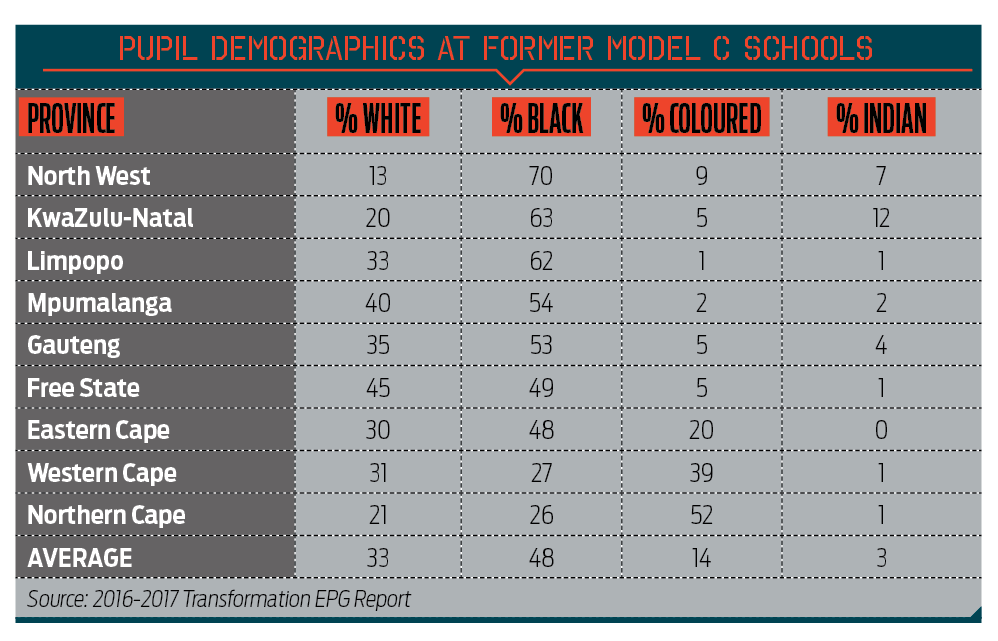South Africa’s top rugby schools need to produce more black talent, writes DYLAN JACK.
Elite schools rugby programmes in South Africa continue to favour a demographic minority despite increased efforts from high schools to transform.
While pupil demographics in South African high schools, especially former Model C schools, better reflect that of the country, some elite rugby schools have still been slow in terms of producing black rugby talent.
Four of the top five rugby schools in 2018 – Grey College, Paul Roos, Paarl Gimnasium and Paarl Boys’ High – fielded majority white 1st XVs, as did Krugersdorp-based Monument and Affies in Pretoria.
Grey College, whose 1st XV went unbeaten last year for the first time since 2011, is considered the best rugby school in South Africa, having produced a total of 22 Springboks since 1996 and 46 overall. However, the fact that all 22 of those Boks have been white, and only one of the 40 Grey products playing first-class rugby is non-white, cannot be ignored.
Grey fielded a largely white 1st XV throughout their unbeaten 2018 season. SA Schools centre Wyclef Vlitoor, who grew up in the Eastern Cape and was given a scholarship by Grey College at age 14, was the only player of colour who had a major role in the 1st XV.
Director of rugby Bobby Joubert says the makeup of last year’s Grey College 1st XV was symptomatic of a previous system, with the school now recruiting more players of colour.
‘At schools level, you do not have to transform or pick players of colour,’ Joubert tells SA Rugby magazine. ‘At Grey College, we see it as our social responsibility to also develop players from smaller areas and schools, such as the country districts.
‘Our main challenge has been financial. To get pupils playing rugby is easy, because we have many players of colour who are good enough after a bit of development with our long-term programme.’
The school’s partnership with Tommix Rugby (Pty) Ltd, an independent company formed at the request of the Grey College governing board and tasked with managing their rugby, is the key to giving more players from underprivileged areas an opportunity at the school.
Joubert, who was appointed to his position through Tommix, claims they are already seeing the rewards of the partnership.
‘We introduced a new system when I was appointed director of rugby in 2017. That is when Tommix Rugby started its association with Grey College. We then got players of colour into the school between U14 and U16 levels. These are the new players coming into the school now, for the next five years.
‘Tommix helps with getting boys to Grey, going on tours, the upgrading of facilities, equipment and paying our high-performance coaches. They make rugby professional at Grey College.
‘The evidence of that system is in Free State winning the U16 Grant Khomo Week, with 22 of our players. There were 10 players of colour, all from Grey, playing in that team, who became national champions.’
Acting Affies headmaster Perry Joynt responded to SA Rugby magazine as follows: ‘As our school’s name shows, we are a 100% Afrikaans medium school with an admission policy approved by the Gauteng Education Department. We welcome all race and language groups in our school and even have a number of current pupils whose home language is not Afrikaans. We expand the talent of the boys who choose to come to our school and believe in fair and equal opportunities for all. We encourage our pupils to participate in all school activities, rugby included. All our teams are chosen on merit.’
Monument headmaster Johann Calitz responded by saying: ‘We at Monnas support and implement transformation as long as it is based on the equal development of all players and the qualities of all individuals are taken into account.’
While Paarl Boys’ also had a largely white 1st XV in 2018, they have notably produced the likes of Gianni Lombard, Manny Rass, Salmaan Moerat and Rhyno Smith, who are all playing first-class rugby in 2019.
‘We choose the best players. We will not work on a quota system,’ says Boishaai director of sport and deputy headmaster, Richard Visagie. ‘It’s important for each boy to know that when he comes into the school, he will be given the best opportunity, no matter the colour of his skin.
‘We are fortunate to be situated in the Western Cape, where we are blessed with boys from every single community,’ Visagie adds. ‘We can afford to develop them from when they arrive in Grade 8, to Grade 12. We then have the privilege of being able to select, in most cases, a team that represents the broader South African community.
‘Unfortunately, schools in other provinces have to go look for players of colour. For example, in the Free State, the coloured players don’t occur there naturally. In the Eastern and Western Cape you are blessed with having those boys on your doorstep.’
Of the top five South African schools sides last year, it was only the Durban-based Glenwood who played with a largely transformed 1st XV team throughout the season. They fielded nine players of colour in their 23-boy squad, which could increase to 12 this year.
Director of rugby and 1st XV coach Derek Heiberg says their excellent track record has more to do with how they challenge and develop players than their location in KwaZulu-Natal.
‘We are trying to holistically develop the boy as opposed to just developing his rugby talent,’ Heiberg says. ‘We challenge the boys on a personal and emotional level.
‘The ones who are responding are those whose family life is not as blessed or there is a lack of parental guidance. They thrive on having a mentorship programme.
‘We don’t necessarily look at colour and say we want this many players of colour in the team. Our recruitment strategy, when we speak to recruiters, is to pick on character and integrity. We have a specific type of person we want within our rugby. Nobody wants to be picked based on the colour of their skin.
‘If you look at what is perceived as being the big schools – Monument, Paarl Boys’, Affies and Grey Bloem – you cannot compare their transformation record to ours.’
Despite being based in an area rich in black talent, Heiberg admits that Glenwood looks to recruit from underprivileged areas in other provinces.
‘For us, it is not linked to where we are based, as 75% of our rugby boys don’t come from KZN. It’s very much due to the programme we are trying to run. Many of our boys come from areas like the Boland and others from Swartland. If they want a better opportunity in life, why should they be denied it?
‘I understand that poaching by big schools is a problem, but if a boy who is at a smaller second- or third-tier rugby school is given a better opportunity at a top rugby school in another province that benefits him as a person, that’s great.’
Eastern Cape schools such as Dale, Queen’s and Selborne field majority black teams and lead the way when it comes to producing black players. This has seen the schools targeted for their young talent. Fifteen black players from Dale played first-class rugby in 2018, including Siviwe Soyizwapi, Aphelele Fassi and Rabz Maxwane, while Queen’s had five, including Kings players Andisa Ntsila, Yaw Penxe and Sibusiso Sithole.
Another part of the issue is that there is no independent authority to monitor whether South Africa’s elite schools are giving enough youngsters from underprivileged areas a chance to join their rugby programmes, as schools rugby falls outside SA Rugby’s jurisdiction.
‘A school’s primary job is to educate children,’ an SA Rugby spokesperson says. ‘A happy by-product for the sport is that some of them play rugby and schools produce rugby players. SA Rugby has an agreed strategic transformation plan for the areas where we have authority and influence – we do not presume to have that over schools. They are regulated by the department of Basic Education.’
However, the latest transformation status EPG report, released by the department of Sport and Recreation, states that the current general school sports system is ‘largely uncoordinated and non-aligned’, and goes on to say that ‘in order to remain competitive, the trend is for the base of high-performance systems of some federations to become increasingly narrower leading to progressively higher levels of exclusivity.’
With South Africa’s professional franchises under increasing pressure to field more players of colour, a more cohesive and less exclusive schools rugby system that has the buy-in of the elite rugby schools, is crucial.
– This feature first appeared in the March 2019 issue of SA Rugby magazine.






